
Recently on Cyclingnews.com |
Tech Feature: Saunier Duval-Prodir team tech, March 16, 2007
Saunier Duval-Prodir sponsors coordinate efforts to supply team riders
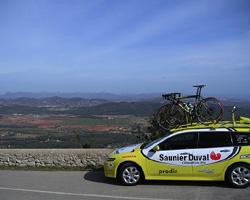
|
The island of Majorca sits just off the coast of Spain and has long served as an ideal training ground for a number of professional cycling teams thanks to its glorious combination of excellent early-season weather, varied terrain, and abundance of good roads. For the Saunier Duval-Prodir team, this setting lies conveniently close to its home base, and Cyclingnews Tech Editor James Huang made the trip to the island to see what the team is riding for 2007.
The Spanish Saunier Duval-Prodir team roster is filled with impressive talent, including Gilberto Simoni, David Millar, and new signing Iban Mayo. Simoni and Mayo have made names for themselves climbing the ascents of the Grand Tours, while Millar is best known for his exploits against the clock. After a long hiatus away from the sport, Millar, in particular, has made a triumphant return to the ProTour, most recently with his prologue win at this year's Paris-Nice.
The team's broad talents are backed by a similarly diverse group of sponsors, including Scott USA, SRAM, Mavic, fi'zi:k, and Castelli, along with others including MET helmets, Topeak, Time, and Hutchinson. Several of these sponsors recently assembled in Majorca during the Saunier Duval-Prodir training camp to formally present the team's new equipment.
Scott Addict: aiming straight for the finish line
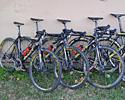
|
Scott engineers pioneered a novel tube-to-tube construction method to produce the groundbreaking sub-900g CR1, a frame which is widely regarded as being responsible for initiating the ultralight frame wars. For 2007, however, Saunier Duval-Prodir riders will be campaigning aboard the new carbon fiber Addict, which shatters that previous mark with a claimed weight as low as 790g.
The Addict utilizes Scott's new IMP (Integrated Molding Process) method to form the one-piece top tube/head tube/down tube in addition to the chainstays (the CR1 method is used for the rest of the frame). Scott claims that IMP uses 11% less material than CR1 while also producing a stronger front end. IMP is also used for the new 330g all-carbon fork.
A new HMX carbon fiber is used in strategic areas of the frame for further weight reduction and stiffening. In order to maximize carbon fiber's effectiveness (carbon fiber offers up its fantastic properties only when the material is in tension), all of the fibers are said to be completely wrinkle-free, and are even 'pre-stretched' to maximize the frame's rigidity and strength.
Speaking of carbon fiber, the Addict is made almost exclusively of the stuff, including the dropouts, front derailleur mount, and even the cable stops. In fact, the only aluminum bits are the bottom bracket shell inserts and rear derailleur hanger (the Addict SL swaps the aluminum shell for a set of proprietary bottom bracket cups co-developed by Shimano).
Scott also graced the new frame with a decidedly more race-oriented geometry than the CR1. In response to requests from pro riders, the Addict incorporates a slacker seat tube angle, a shorter head tube, and a longer top tube, all in the name of more aggressive positioning.
Mavic goes further upscale with Cosmic Carbone Ultimate
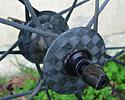
|
In seeking the "perfect balance between light weight, stiffness, and aerodynamics," Mavic has gone on a carbon fiber binge diet to develop its new Cosmic Carbone Ultimate. The new wheelset utilizes carbon fiber for the rims, front hub shell, and even the spokes, all of which are co-molded and/or bonded together to form a single structure. Published weights are certainly top-tier at just 1185g per pair, as is the suggested retail price of US$2750.
In addition to the new nearly all-carbon content, the Cosmic Carbone Ultimate uses a new (for Mavic, at least) construction method. New unidirectional bladed carbon fiber spokes now stretch the entire span of the wheel, being first bonded to one side of the rim, then passing through the carbon hub shell flange, and then bonded again to the other side of the rim. The only exception to this is the non-driveside of the rear wheel, which incorporates short threaded sections of spoke to allow for wheel truing. According to Mavic, the new spokes are not only more aero than a traditional 1.8mm diameter stainless steel spoke, but also twice as stiff and 35% lighter.
Since the spokes are bonded directly to the inner walls of the 40mm-deep tubular-only carbon rims, the need for spoke holes is completely eliminated, and the addition of a sealed valve hole makes the rims totally weatherproof. The rear rim is also asymmetric for more balanced spoke tension.
High-tech fabrics and cuts from Castelli
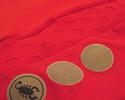
|
Saunier Duval-Prodir clothing sponsor Castelli claims to equip the team with the only two-material jersey in all of the ProTour. The front of the team jersey is based on the same material Castelli uses on its aerodynamic Split Second jersey, while the rear is made of a hardier material for better pocket support. According to Castelli, the super elastic and form-fitting front of the jersey provides much of the benefit of the Split Second even without that jersey's dimpled fabric, to the tune of 40 seconds saved per 40km (the Split Second claims to save 58s per 40km).
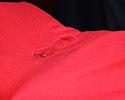
|
Team shorts are based on Castelli's "Free Bib" concept, which includes radically wide-set and narrow straps along with a low cut front, and the gripper elastic at the legs is omitted in favor of a wide band of Lycra. A new-for-2007 chamois utilizes a triple-density "ComforTemp" material to prevent overheating, and the chamois is sized such that it's just large enough to cover the saddle.
For climbing stages, Castelli will supply Simoni, Mayo, and others with its new Superleggera jersey. The Superleggera is built with a new ultralight material which yields a short-sleeved jersey weighing just 69g (in large). In addition, Castelli says the material will barely absorb water, meaning that it won't get heavier during the typically hot conditions of the Tour and Vuelta, and won't feel cold on the way back down since there is little fluid to evaporate.
For time trial specialist Millar, Castelli will construct a special skinsuit utilizing the dimpled fabric from its Split Second jersey. Unlike the Split Second, which uses dimpled fabric only for the leading edges, Millar's suit will ultimately use the unique fabric throughout for maximum time savings. Ultimately, Castelli's goal is to also integrate full-finger gloves into the sleeves to reduce turbulence at the wrist.
Finally! TT gear from SRAM
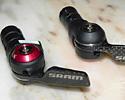
|
After much speculation, SRAM finally introduced time trial-specific gear in the form of a pair of bar-end shifters and time trial-specific brake levers. SRAM's new TT shifter (there is no specific model designation for either the shifters or brake levers) are said to be the lightest on the market at just 140g per pair. No, they don't incorporate any sort of DoubleTap internals, opting instead for a conventional mechanism. Weight savings are achieved through the use of a true carbon fiber lever, composite body and expander wedges, and aluminum hardware.
One unique feature is the adjustable rotational positioning of the levers themselves. Instead of the industry-standard "levers up or levers down" options, the lever itself on SRAM's new shifter can actually be rotated to the user's liking to provide a truly custom fit. As expected, the new shifters will work only with SRAM's Force and Rival rear derailleurs, and is offered exclusively in 10s rear/friction front configurations (there is no friction option for the rear). Shifters should be on the market at the time of this writing for a retail price of US$195 for the pair.
The new TT brake levers also use a carbon fiber lever blade, composite body, and the same expander wedge system as on the TT shifters. Although extremely light at a claimed 99g for the pair, SRAM says that the new levers make no compromises in terms of ergonomics or braking ability. Brake levers will be offered both as a pair and individually, with sets retailing for US$118.
Riding through the Majorca countryside
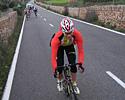
|
Cyclingnews had the opportunity to test ride Saunier Duval-Prodir's actual team bikes (my bike came courtesy of Frenchman Christophe Rinero), fully equipped with Mavic's new wheels, SRAM Force components, and cockpit bits and pieces from Ritchey and fi'zi:k. After a few days of rolling along the roads of Majorca, it's no wonder why so many teams train there; rolling terrain is in abundance, and there is a surprising amount of climbing to be had if you want it.
The edgy handling of Scott's new race geometry doesn't necessarily cross over into the 'nervous' realm, but it definitely requires one's undivided attention. Drivetrain and overall frame responsiveness are outstanding, and one can dive into steep downhill switchbacks with reassuring confidence.
In spite of the racier fit and position, Scott also managed to make the Addict slightly more comfortable. Whereas the CR1 would have the occasional tendency to make smaller impacts feel more square-edged, the Addict incorporates just enough vibration damping to maintain sensation in your hands without detracting from road feel. That being said, larger impacts are still met with a solid kick in the rear, but that is to be expected.

|
Mavic clearly nailed the 'stiff' goal with the new Cosmic Carbone Ultimate, as these are easily the most rigid-feeling wheels this tester can remember. According to team rider David Millar, "There is no flex in these wheels." Normally those sorts of words would be categorized into marketing hyperbole, but in the case of the Cosmic Carbone Ultimate, the incredible lateral and torsional stiffness is immediately noticeable from the first pedal stroke, and not in any sort of subtle manner. Just to make sure we weren't imagining things, we also rode the bike with a set of Mavic's Ksyrium ES wheels which only served to reinforce our initial impressions.
One of Majorca's less-endearing traits is its tendency for crosswinds, and there certainly was no lack of them during our trip. Mavic claims that the new wheelset scores roughly the same as its Ksyrium ES in this respect, and we would almost argue that the deep-section Cosmic Carbone Ultimate actually felt more stable. High-speed aerodynamics were also obviously quite good, and the light weight was most welcome on one particularly steep climb.
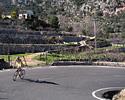
|
Braking on the new wheels was somewhat harsh, at least when equipped with Swiss Stop Yellow King pads (recommended by Mavic). To be fair, we'd personally have braking performance lie more on the grabby side of things than the non-existent one, and racers normally will enter corners hot and brake late, anyway. Once accustomed to the grabbiness, however, braking was predictable, quiet, and most importantly, quite powerful.
We didn't have the opportunity to ride SRAM's new TT gear on the road, but the new components at least feel quite solid when playing with them on static ground. As with the DoubleTap shifters, the new shifters deliver a firm tactile and audible feedback.
Likewise, we didn't test Castelli's newest garment offerings in Spain, but keep posted in the future for a full product review.
Top level equipment for a top level team
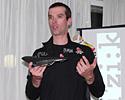
|
Saunier Duval-Prodir certainly has some lofty ambitions for the season ahead. As in other top-tier levels of sport, the sponsors have stepped up to the plate to assist the riders in achieving those goals and Millar's prologue win at Paris-Nice certainly bodes well. Although we only had a brief taste of what this true ProTour team uses, it's clear that there is little left to be desired in terms of equipment. Stay tuned for more in-depth product reviews of some of Saunier Duval-Prodir's gear, including one special project…
Photography
For a thumbnail gallery of these images, click here
Images by Castelli
- Saunier Duval-Prodir's team jerseys will be hard to miss in the peloton, courtesy of a bold design by Castelli.
- Castelli claims to provide the Saunier Duval-Prodir team with the ProTour's only two-material jersey.
- Team shorts are based on Castelli's "Free Bib" concept.
- Super narrow and widely-set bib straps combine with the low-cut front to provide a light and airy feel.
Images by James Huang/Cyclingnews.com
- Castelli says its dimpled Split Second jersey will save a rider 58 seconds over a 40km time trial as compared to a standard jersey.
- A flap covers the rear pockets on the Split Second jersey to prevent bellowing.
- The Superleggera material is nearly water resistant on its own, without the need for any coating.
- David Millar explains the benefits of Mavic's new Cosmic Carbone Ultimate wheelset.
- David Millar is particularly fond of the extended length of fi'zi:k's Arione saddle, saying the long flat nose is ideal for time trials.
- The Majorca countryside is littered with orchards.
- Breakaway!
- A beautiful sunset over the Majorca coast.
- Rolling terrain covers most of the Majorca landscape, but climbs are in abundance as well if you want them.
- Mavic includes adjustable spokes on the non-driveside of the rear wheel to allow for minor truing.
- Rear rim incorporates an asymmetric spoke bed for more even spoke tension.
- The front hub utilizes narrow-profile flanges.
- Carbon fiber is used for all of the front hub shell.
- Mavic says its new Cosmic Carbone Ultimate wheelset strikes the perfect balance between light weight, stiffness, and aerodynamics.
- Rear hub shell is primarily aluminum, but also uses a carbon driveside flange.
- The Cosmic Carbone Ultimate rim wears a 40mm-deep aero profile.
- Spokes are molded directlly to the carbon rim.
- Valve hole is sealed on all sides for true weatherproofness.
- A Saunier Duval-Prodir team car awaits…
- Scott's new Addict uses aluminum only in the bottom bracket shell inserts and replaceable rear derailleur hanger.
- A fleet of Scott Addicts ready to hit the road.
- Scott uses a new IMP technique to form the front triangle.
- Saunier Duval-Prodir's ride for 2007.
- The Addict foregoes curvy stays but is surprisingly comfortable for a race bike nonetheless.
- The carbon fiber blades of SRAM's new TT brake levers are hollow for reduced weight.
- Composite expander wedges on the new brake lever.
- SRAM finally formally enters the TT market with its new brake levers.
- Shifters use the same expander system as on the brake levers.
- SRAM's TT shifters are finally here!
- "3V" is code for "Venga, venga, venga!!!"

